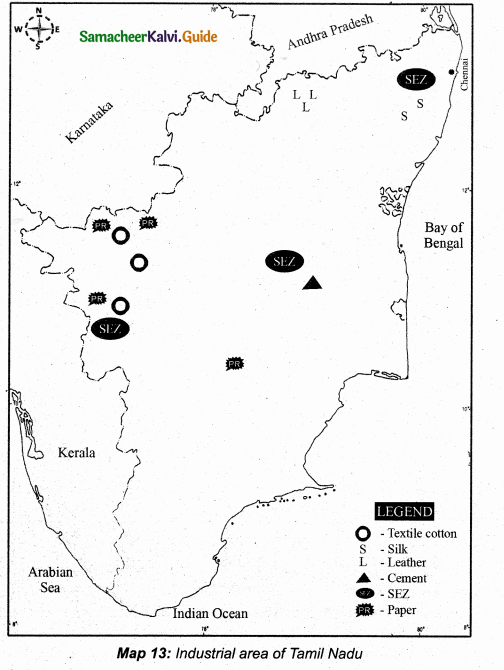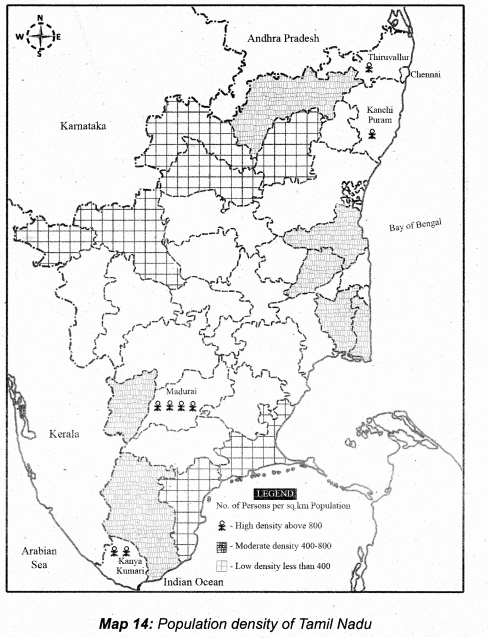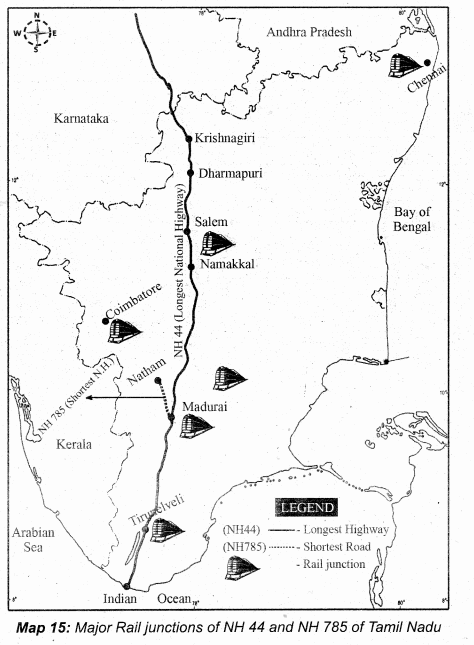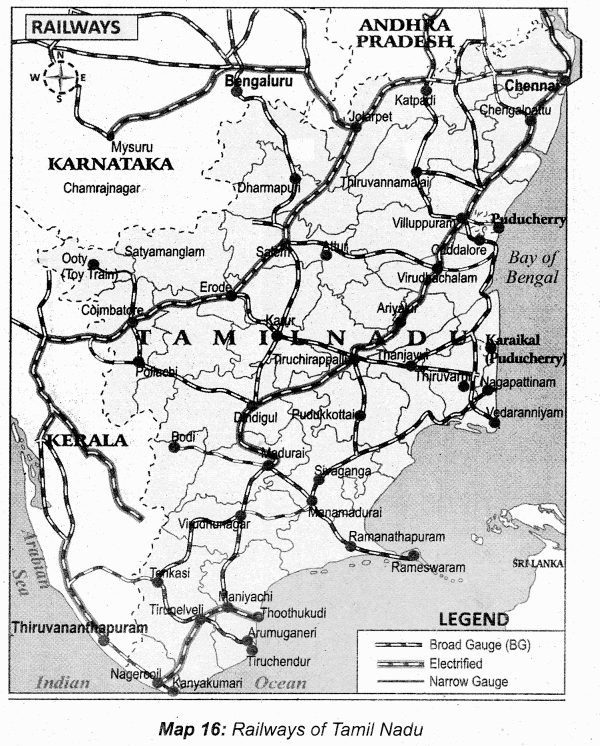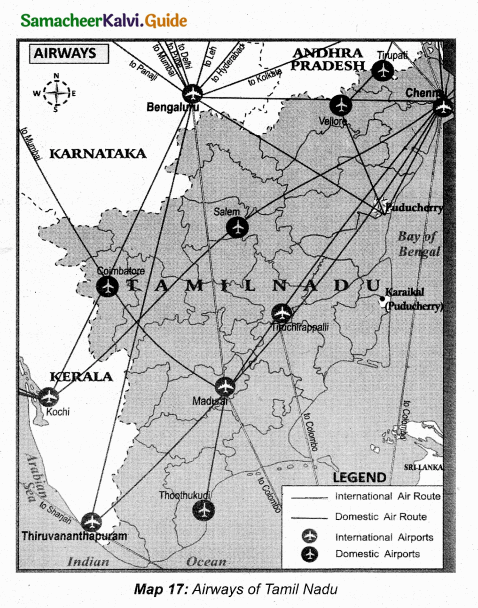Students can download 10th Social Science Geography Chapter 7 Human Geography of Tamil Nadu Questions and Answers, Notes, Samacheer Kalvi 10th Social Science Guide Pdf helps you to revise the complete Tamilnadu State Board New Syllabus, helps students complete homework assignments and to score high marks in board exams.
Tamilnadu Samacheer Kalvi 10th Social Science Solutions Geography Chapter 7 Human Geography of Tamil Nadu
Samacheer Kalvi 10th Social Science Human Geography of Tamil Nadu Text Book Back Questions and Answers
I. Choose the correct answer
Question 1.
The delta which is known as Granary of South India is:
(a) Cauvery delta
(b) Mahanadi delta
(c) Godavari delta
(d) Krishna delta
Answer:
(a) Cauvery delta
Question 2.
Second staple food of the people of Tamil Nadu is ……………
(a) Pulses
(b) Millets
(c) Oilseeds
(d) Rice
Answer:
(b) Millets
Question 3.
Literacy rate of Tamil Nadu as per 2011 census is:
(a) 80.32%
(b) 62.33%
(c) 73.45%
(d) 80.33%
Answer:
(d) 80.33%
![]()
Question 4.
A major hydro-electric power project of Tamil Nadu is …………..
(a) Mettur
(b) Papanasam
(c) Sathanur
(d) Tungabhadra
Answer:
(a) Mettur
Question 5.
Number of major and minor ports in Tamil Nadu are:
(a) 3 and 15
(b) 4 and 15
(c) 3 and 16
(d) 4 and 15
Answer:
(a) 3 and 15
II. Fill in the blanks
- Agriculture of Tamil Nadu constitutes ………………. % of its economy.
- Sathanur dam is constructed across the river ……………….
- Tamil Nadu ranks ………………. in India with a share of over 20% in total road projects under operation in the Public – Private Partnership (PPP).
- ………………. is the third largest airport in India after Mumbai and Delhi.
- The difference between the value of exports and imports is called ……………….
Answers:
- 21%
- Then Pennai
- second
- Chennai
- balance of trade
![]()
III. Match the following

Answer:
A. (ii)
B. (iv)
C. (i)
D. (iii)
IV. Questions 1-2 are assertion and reasoning type
Question 1.
Assertion (A): Coimbatore, Tiruppur and Erode region is called as The Textile Valley of Tamil Nadu.
Reason (R): They contribute a major share to the state’s economy through textiles.
(a) Both (A) and (R) are true and (R) explains (A)
(b) Both (A) and (R) are true but, (R) does not explain (A)
(c) (A) is true but (R) is false
(d) (A) is false but (R) is true
Answer:
(a) Both (A) and (R) are true and (R) explains (A)
Question 2.
Assertion (A): The Nilgiris is the least populated district of Tamil Nadu. Reason (R): It is located in the western most part of Tamil Nadu.
(a) Both (A) and (R) are true and (R) explains (A)
(b) Both (A) and (R) are true but, (R) does not explain (A)
(c) (A) is true but (R) is false
(d) (A) is false but (R) is false
Answer:
(d) (A) is false but (R) is false
![]()
V. Answer the following in brief
Question 1.
Explain the cropping seasons of Tamil Nadu.
Answer:
The farmers select different crops for different seasons of cultivation based on the temperature and availability of moisture in the soil.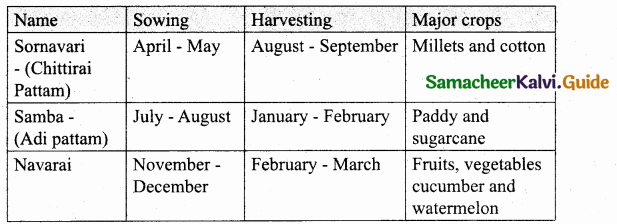
Question 2.
Why is Coimbatore called the Manchester of Tamil Nadu?
Answer:
Maximum units are concentrated in and around Coimbatore region. For this region, it is known as the “Manchester of South India”. It is known as such because of presence of more than 25,000 small, medium, large scale industries and textile mills.
Question 3.
Name the important multipurpose projects of Tamil Nadu.
Answer:
The important multipurpose project of Tamil Nadu are:
- Mettur Dam – River Cauvery – Mettur (Salem)
- Bhavani Sagar Dam – Bhavani – Erode
- Amaravathi Dam – Amaravathi – Udumalpet (Tirupur)
- Krishnagiri Dam – Cauvery – Krishnagiri
- Sathanur Dam – Then Pennai – Chengam
- Mullai Periyar – Periyar – Tamil Nadu, Kerala Border fix) Vaigai Dam – Vaigai – Andipatti (Theni)
- Manimuthar Dam – manimuthar – Tirunelveli
- Papanasam Dam – Karaiyar – Tirunelveli
- Parambikulam Aliyar – Aliyar and Parambikulam – Joint venture of Tamil Nadu and Kerala.
Question 4.
What is MRTS?
Answer:
MRTS means mass Rapid Transport System and currently developing a Metro System, with its first underground stretch in operation since May 2017.
![]()
Question 5.
List out the air ports and sea ports of Tamil Nadu.
Answer:
Airports: Chennai, Coimbatore, Madurai and Tiruchiraplli.
Sea ports:
Three major sea ports – Chennai, Ennore, Tuticorin. An intermediate port at Nagapattinam and 51 minor ports are there in Tamil Nadu.
Question 6.
Have you heard about any stampede in your district? Write about that incident briefly.
Answer:
Do it yourself.
![]()
VI. Distinguish between the following
Question 1.
Marine Fishing and inland fishing.
Answer:
Marine Fishing:
- Fishing is carried out in ocean and sea in shore fishing and off shore fishing.
- Fish varieties caught are sharks, flying fish, counch, cat fish, silver bellies and crabs.
- Large mechanised boats are used.
- Chennai, Kanyakumari, Tirunelveli, Nagapattinam, Thanjavur and Ramanathapuram are the major areas.
Inland Fishing:
- Fishing is carried out in lakes, rivers, ponds, estuaries, backwaters and swamps.
- Carp, Tilapia, Barbus, Rohu, catla and mrigal are caught. Oyster and prawns are cultured in nurseries.
- Catamaran, diesel boats and floating nets are used.
- Vellore leads in inland fishing production followed by Cuddalore, Sivagangai and Virudhunagar districts.
Question 2.
Food crops and non-food crops.
Answer:
Food Crops:
- Staple food crops paddy, millets and pulses.
- From the major source of regular diet.
- Mostly grown under subsistence farming the excess is given for sale
Non – Food Crops:
- Oil seeds, sugarcane, cotton and plantation crops.
- Mainly used for commercial purpose (cash crops).
- Mostly grown and commercial farming mainly grown for agro-based manufacturing sector.
Question 3.
Surface water and groundwater.
Answer:
Surface Water:
- Water available on the surface of the earth in lakes, ponds, rivers, stream, reservoirs etc.,
- The surface water is put in to various uses like drinking, for hydelpower, irrigation etc.
- Availability depend upon the rainfall nature of soil, land form temperature etc.
- Not reliable
- May be polluted and contaminated by the external forces.
Ground Water:
- Water found underground at deep in large aquifers (porous rock layers) by seeping the soil.
- Water has to be pumped out by drilling a deep well.
- Availability depend upon the nature of absorption by the aqueous layer of rocks.
- Reliable sources of water.
- Mostly polluted due to depth.
![]()
VII. Give reasons for the following
Question 1.
Farmers switch over from inorganic to organic farming.
Answer:
To promote organic farming a central scheme named ‘National Project on Organic Farming’ was launched Apart from general things, the scheme provides financial assistance through Capital investment Subsidy Scheme for agro-waste compost production units, bio-fertilizers/ bio-pesticides production units, development and implementation of a quality control regime, human resource development etc. In organic farming synthetic fertilizers, pesticides, growth regulator and livestock feed additives are not used. This type of fanning rely on crop rotation, crop residues, animal manure, off-farm organic wastes and biological pest control to maintain soil productivity.
Question 2.
Cities are densely populated than the villages.
Answer:
Cities are densely populated than villages because of several facilities like education, recreation, medical and mainly employment opportunities in various sectors to earn for their livelihood.
Question 3.
Karur is Called the Textile Capital of Tamil Nadu.
Answer:
Karur is a well known industrial centre the city is famous for cottage and handloom textiles. It exports all kinds of textile items all over the world.
Question 4.
Mostly stampede occurs in Temples.
Answer:
During festival seasons in temples people from all over gather in thousands or lakhs. Sometimes the uncontrolled crowds when they move towards each other (to and fro) may push each other. The packed situation and lack of space lead to panic and asphysciation that make breathing very difficult and stampede occurs.
![]()
VIII. Answer the following in a paragraph
Question 1.
Write about the plantation farming of Tamil Nadu.
Answer:
- Tea, coffee, cashew, rubber and cinchona are the major plantation crops of the state.
- Tamil Nadu ranks second in area and production of tea in India next to Assam.
- Tea plantations are found in the hills of the Nilgiris and Coimbatore.
- Coffee plants are grown in the hills of Western Ghats as well as Eastern Ghats.
- The Nilgiris and Yercaud in Salem are the notable regions for tea plantations.
- It is also found in the hilly slopes of Dindigul, Madurai, Theni and Dharmapuri districts.
- Tamil Nadu stands second in area and production of coffee next to Karnataka.
- Rubber plantations are significant in Kanyakumari.
- Pepper is confined to the warm and wet slopes of Eastern and Western Ghats of Tamil Nadu
- Cashew is extensively cultivated in Cuddalore district.
- Cinchona is planted at heights varying from 1060 to 1280 metres in Anaimalai hills.
- Cardamom estates are located at few places in the hills of the Madurai region at an elevation of 915 to 1525 metres.
![]()
Question 2.
Give an account on water resources of Tamil Nadu.
Answer:
Tamil Nadu has only 2.5% of India’s water resources. More than 95% of the surface water and 80% of the ground water have already been put into use.
Major uses of water: It include human / animal consumption, irrigation and industrial use.
Rainfall: The state is mainly dependent on monsoon rains. The average annual rainfall is around 930 mm. 47% during north east monsoon, 35% during the south west Monsoon 14% in summer and 4% in winter.
Surface water Resources: River Basin, Reservoirs, Tanks, Tube wells and other wells and open wells. Approximately getting 20,46,788 million cubic metres.
Question 3.
Bring out the mineral distribution in Tamil Nadu.
Answer:
Tamil Nadu is the leading holder of country’s. resources of vermiculite, magnetite, dunite, rutile, garnet, molybdenum and ilmenite.
Contribution for the country’s mineral resources:
75% vermiculite, 55.3% lignite, 69% dunite, 52% molybdenum, 59% garnet, 30% titanium.
Important Minerals and area of occurrence:
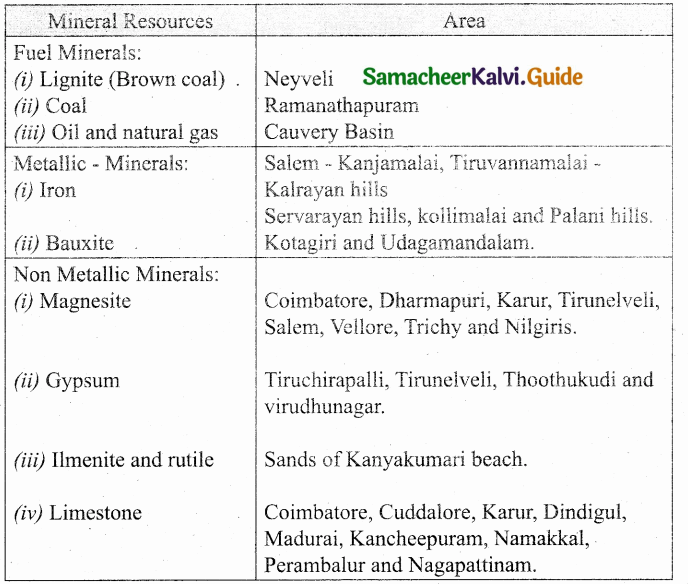
In some parts of the state feldspar, quartz, copper and lead also found in less quantity.
![]()
Question 4.
State the densely populated regions of Tamil Nadu and account for its high density.
Answer:
- The plains with suitable climate, the coasted plains with mild temperature and large towns are densely populated.
- The state ranks 12lh among the Indian States in population density.
- The nation average density of population as per the 2011 census in 382. Chennai is the densest district with 26,903 person per sq. km.
- Followed by Kanyakumari – 1106
Tiruvallur – 1049
Kancheepuram – 927
Madurai – 823
Coimbatore – 748
Cuddalore – 702
Thanjavur – 691
Nagapattinam – 668
Salem – 663
Vellore – 646
Tiruchirappalli – 602
These are the regions with high density of population.
Question 5.
Explain the different modes of transport available in Tamil Nadu.
Answer:
Road ways:
- The state has a total road length of 1,67,000 km. 60,628 km are maintained by state Highways department.
- It ranks second in India with a share of over 20% in total road projects under operation in the Public Private Partnership (PPP) model.
Railways:
- As a part of Southern Railway with headquarters at Chennai, Tamil Nadu has well developed rail network.
- Tamil Nadu has a total railway track length 6,693 km with 690 railway station.
- Main Junctions: Chennai, Coimbatore, Erode, Madurai, Salem, Tiruchirapalli and Tirunelveli.
- Chennai has a well established suburban railway network a Mass Rapid Transit System (MRTS) and is currently developing a metro system with its first underground stretch in operation since May 2017.
Airways:
- Increased industrial activity has given rise to an increase in passenger traffic as well as freight movement. It has been growing over 18% per year.
- Major International Airports – Chennai, Coimbatore, Madurai and Tiruchirapalli. Chennai International airport is the third largest airport in India next to Mumbai and Delhi.
- Domestic Airport – The state has domestic airports at Tuticorin and Salem connecting several parts of the country.
Waterways:
- Tamil Nadu has three major ports – Chennai, Ennore and Tuticorin.
- Minor ports – About 15 and Nagapattinam serves as an intermediate port.
Cargo handling:
- 24% of India’s cargo is handled by the ports of Tamil Nadu. They are currently capable of handling over 73 millions metric tonnes of cargo annually.
- All the minor ports are managed by the Tamil Nadu Maritime Board, Chennai port.
- Chennai port – It is an artificial harbour and the second principal port in the country for handling containers.
- It is currently upgraded to have a dedicated terminal for cars capable of handling 4,00,0000 vehicles.
- Ennore port – It was recently converted as a major port and handles the major coal and are traffic in Tamil Nadu.
![]()
Question 6.
Write about Road safety rules.
Answer:
- Aware of the road signals
- Stop, look and cross
- Listen and ensure whether a vehicle is approaching
- Don’t rush on roads
- Crossroads in pedestrian crossings
- Don’t stretch hands while driving vehicles
- Never crossroad at bends and stay safe in a moving vehicle
![]()
IX. Map study
Question 1.
Mark the areas of major crops, minerals, dams, airports and seaports.
Answer:
(a) On an outline map of Tamil Nadu the areas of major crops.
- Paddy – Thanjavur, Tiruvarur, Tirunelveli
- Millets – Coimbatore, Dharmapuri, Vellore, Perambalur.
- Pulses – Coimbatore, Tiruvarur, Nagapattinam, Thoothukudi, Krishnagiri.
- Oil seeds – Vellore, Tiruvannamalai, Villupuram, Salem, Pudukottai.
- Sugarcane – Kancheepuram, Tiruvallur, Cuddalore, Erode, Tirunelveli.
- Cotton – Coimbatore, Salem, Madurai, Ramanathapuram, Virudhunagar.
- Tea and coffee – Nilgiris, Kodaikanal, Kanyakumari, Anaimalai hills.
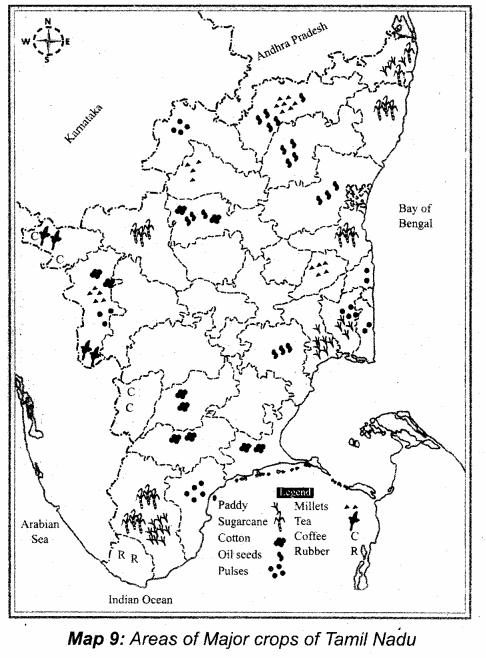
(b) Distribution of minerals:
Refer VIII. Paragraph Q. No 3 for Distribution of minerals areas.
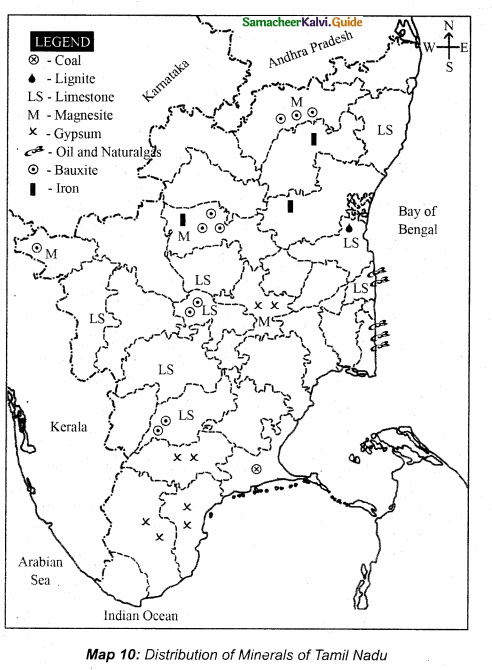
(c) Dams:
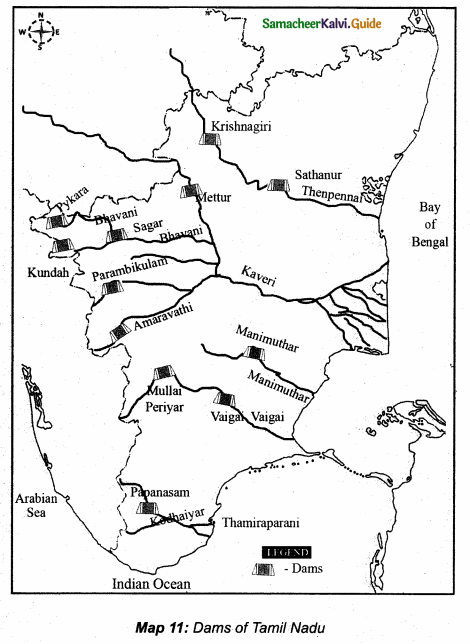
(d) Seaports and airports:
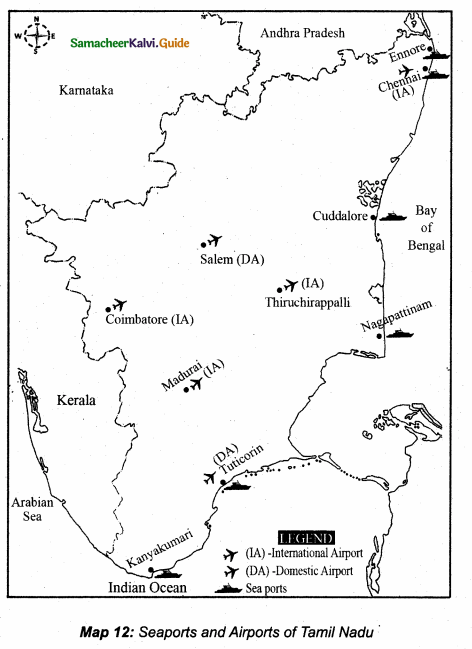
Samacheer Kalvi 10th Social Science Human Geography of Tamil Nadu Additional Important Questions and Answers
I. Choose the correct answer
Question 1.
A triangular-shaped alluvial tract formed at the mouth of the river:
(a) Doab
(b) Bay
(c) Delta
(d) Harbour
Answer:
(c) Delta
Question 2.
Agriculture is the ………….. and traditional occupation.
(a) Primary
(b) Secondary
(c) Service
Answer:
(a) Primary
Question 3.
……………….. with alluvial soil enhances agricultural productivity.
(a) hills
(b) plateaus
(c) plains
(d) dry lands
Answer:
(c) plains
![]()
Question 4.
Pearl fishing is predominant in ………….. region.
(a) Gulf of Mannar
(b) Rameshwaram
(c) Chinna muttom
Answer:
(a) Gulf of Mannar
Question 5.
India observed as ……………….. national year of millets.
(a) 2015
(b) 2016
(c) 2017
(d) 2018
Answer:
(d) 2018
Question 6.
The Manchester of South India is ……………..
(a) Salem
(b) Coimbatore
(c) Mumbai
Answer:
(b) Coimbatore
Question 7.
……………….. is the major oil seed of the Tamil Nadu state.
(a) Coconut
(b) Ground nut
(c) Sunflower
(d) Gingelly
Answer:
(b) Ground nut
![]()
Question 8.
The Headquarters of the Southern Railways is in …………….
(a) Chennai
(b) Cochin
(c) Mumbai
Answer:
(a) Chennai
Question 9.
……………….. is also called inshore fishing or neritic fishing.
(a) Oyster cultivation
(b) Inland fishing
(c) Marine fishing
(d) Pearl fishing
Answer:
(c) Marine fishing
Question 10.
…………….. dam was built by British administration in 1895.
(a) Cauvery
(b) Mettur
(c) Mullaiperiyar
Answer:
(c) Mullaiperiyar
Question 11.
……………….. is one of the biggest Earthen dams in the country.
(a) Mullai Periyar Dam
(b) Bhavani Sagar Dam
(c) Mettur Dam
(d) Sathanur Dam
Answer:
(b) Bhavani Sagar Dam
Question 12.
……………….. is also known as ‘Karaiyar Dam’.
(a) Papanasam Dam
(b) Vaigai Dam
(c) Manimuthar Dam
(d) Krishnagiri Dam
Answer:
(a) Papanasam Dam
Question 13.
……………….. silk is unique in its quality and traditional value all over the world.
(a) Ami
(b) Salem
(c) Kancheepuram
(d) Banaras
Answer:
(c) Kancheepuram
Question 14.
The lowest literacy rate is found in ……………….. district.
(a) Kanyakumari
(b) Coimbatore
(c) Nilgiris
(d) Dharmapuri
Answer:
(d) Dharmapuri
Question 15.
……………….. is the shortest national highway in Tamil Nadu.
(a) NH7
(b) NH44
(c) NH785
(d) NH4
Answer:
(c) NH785
Question 16.
“Fire works” capital of India is:
(a) Sivakasi
(b) Salem
(c) Kamr
(d) Erode
Answer:
(a) Sivakasi
![]()
Question 17.
……………….. is the official enumeration of population-based on various aspects.
(a) Density
(b) Census
(c) Religion
(d) Stampede
Answer:
(b) Census
Question 18.
At districts level ……………….. is the Chairman of disaster management in the state.
(a) Local Police
(b) Civil Defence
(c) District Magistrate
(d) District Collector
Answer:
(d) District Collector
Question 19.
As per 2011 census the rural population of the state is:
(a) 48.40%
(b) 11.19%
(c) 60.07%
(d) 51.60%
Answer:
(d) 51.60%
Question 20.
The rapid increase of ……………….. may retard economic growth.
(a) population
(b) literacy
(c) agriculture
(d) industries
Answer:
(a) population
![]()
II. Fill in the blanks
- The ………………. are the most significant resource on the earth surface.
- ………………. is the mainstay of the state’s economy.
- ………………. is the major sources of rainfall for Tamil Nadu.
- Fruits and vegetables are mainly cultivated in ………………. cropping season.
- FAO has decided to observe ………………. as the International year of millets.
- Tamil Nadu co-operative Milk Producers Federation Limited is popularly known as ……………….
- With very low investments ………………. can be made into profitable venture for small farmers.
- Fishing done in 20 – 30 miles away from the shore is known as ……………….
- Vaigai dam is has its surname as ………………. due to its unique as
- Parappalar project is located near ……………….
- The percapita availability of water resources in Tamil Nadu is just ………………. cubic metres.
- Coimbatore, Tirupur and Erode region is referred as ……………….
- ………………. convert raw materials into usable product or goods.
- ………………. districts has some specialised areas for the manufacturing of synthetic silk clothes.
- Hundreds of leather tanneries are located around ………………. district.
- Vellore leather accounts for more than ………………. % of leather and related products.
- ………………. paper mill in Karur was started in the year 1979.
- G.l Tag of Nagercoil is its ……………….
- Pattamadai is famous for ……………….
- ………………. is the second largest software exporter next to Karnataka.
- Tamil Nadu accounts for ………………. % automobile components produced in India.
- The single largest cottage industry in the state is the ……………….
- ………………. is an area in which business and trade laws are different from the rest of the country.
- ………………. refers to the number to people living in a defined area.
- If any district has a population of about 15 – 20 lakhs it cames under ………………. population category.
- ………………. district is the least populated one.
- The ………………. represents the number of females per 1000 males.
- The ………………. is the commercial part of a harbour with the facility of loading and unloading of goods and storage of cargo.
- N.H 785 runs from to to a distance of 35 km.
- ‘1077’ is the ………………. contact number.
- The state Disaster management Authority chairman is ……………….
- Education on awareness regarding the disasters may help in the ………………. during disasters.
- ………………. is a deposit in the earth crust with one or more value minerals.
- ………………. are the people with the ability to read and write.
- ………………. is a large natural or artificial lake used as a source of water supply.
- ………………. is the statistical study of the characteristics of human population.
- ………………. are the people who make a deep and detailed study of the population.
- ………………. is one of major problem confronting our nation with all its evil effects.
- ………………. is reared in the arid, semi-arid and mountainous areas in Tamil Nadu.
- ………………. is the best alternative for rearing in the marginal and undulating lands.
Answer:
- human beings
- Agriculture
- North-East monsoon
- Navarai
- 2023
- Aavin
- goat rearing
- off-shore fishing
- little – Brindavan
- Ottanchatram
- 900
- Textile Valley of Tamil Nadu
- Industries
- Ramanathapuram
- Vellore
- 37
- Kagithapuram
- Temple Jewellery
- mats
- Tamil Nadu
- 35%
- handloom sector
- Special Economic Zone ,(SEZ)
- Population
- Moderate
- The Nilgiri
- Sex – Ration
- Port
- Madurai to Nattham
- control room of district Collector / Magistrate
- Chief Minister
- reduction of risks
- Ore
- Literates
- Reservoirs
- Demography
- Demographers
- Over population
- Sheep
- Goat
![]()
III. Match the following
Question 1.
Match the Column I with Column II

Answer:
A. (iv)
B. (v)
C. (i)
D. (iii)
E. (ii)
Question 2.
Match the Column I with Column II

Answer:
A. (iv)
B. (v)
C. (i)
D. (ii)
E. (iii)
IV. Assertion and Reason
Question 1.
Assertion (A): Vellore is the top exporter of finished leather goods.
Reason (R): Hundreds of leather tannaries are located around Vellore.
(a) Both (A) and (R) are correct (R) is the correct explanation of (A)
(b) (A) is true (R) is false.
(c) (A) is false (R) is true.
(d) Both (A) and (R) is correct R does not explains (A).
Answer:
(a) Both (A) and (R) are correct (R) is the correct explanation of (A)
Question 2.
Assertion (A): TNPL is one of the most accomplished paper mill in the world. Reason (R): TNPL is a Government of Tamil Nadu enterprise.
(a) Both (A) and (R) is correct (R) explains of (A).
(b) Both (A) and (R) are correct but (R) does not explains (A).
(c) (A) is correct (R) is false.
(d) Both (A) and (R) are false.
Answer:
(b) Both (A) and (R) are correct but (R) does not explains (A).
Question 3.
Assertion (A): Industrial disaster are caused by negligence or incompetence. Reason (R): Over heating and use of high quality control.
(a) Both (A) and (R) is true.
(b) (A) is correct (R) is false.
(c) Both (A) and (R) is correct (R) explains (A).
(d) Both (A) and (R) is correct but (R) does not explains (A).
Answer:
(b) (A) is correct (R) is false.
Question 4.
Assertion (A): Cropping seasons in Tamil Nadu have different types of crop cultivation.
Reason (R): Cultivation of crops depend on the temperature and availability of moisture.
(a) Both (A) and (R) is true (R) explains (A).
(b) (A) is correct (R) is false.
(c) (A) is false (R) is correct.
(d) Both (A) and (R) is correct but (R) does not explain (A).
Answer:
(d) Both (A) and (R) is correct but (R) does not explain (A).
![]()
V. Answer the following in brief
Question 1.
What is Agriculture?
Answer:
It is the process of producing food, feed fiber and many other desired products by the cultivation of certain plants and the raising of domesticated plants.
Question 2.
What do you mean by “Human Geography”.
Answer:
Human Geography refers to the study of ways of development of human societies and their operation in relation to their physical environment.
Question 3.
What is Port?
Answer:
The commercial port of a harbour with the facility of loading and unloading of goods and space for the storage of cargo.
Question 4.
Name the types of agriculture practices followed in Tamil Nadu and their regions.
Answer:
Farming Type:
- Subsistence intensive agriculture
- Plantation agriculture
- Mixed farming
Regions:
- All over Tamil Nadu except few regions
- Hill slopes of Eastern and Western Ghats
- Banks of R. Cauvery and ThenPennai
Question 5.
Define Birth rate:
Answer:
The number of live births per annum per thousand people in a region is called birth rate.
![]()
Question 6.
What are the conditions required for the cultivation of pulses?
Answer:
- Pulses are mostly grown in drier regions with or without irrigation.
- Mild cool climate and a low to moderate rainfall are best suited for these crops.
Question 7.
What are the important pulses varieties grown in Tamil Nadu? and their uses.
Answer:
- Bengal gram, black gram, green gram, cow pea, and horse gram.
- Uses: Pulses are the major sources of protein and they serve as excellent fodder.
Question 8.
What do you understand by the term ‘mixed farming’?
Answer:
It is a type of farming which involves both growing of crops and the raising of live-stock simultaneously in a land holding.
Question 9.
What are fibre crops?
Answer:
- Fibre crops include cotton and jute.
- Cotton thrives well in black soil.
- It is the major fibre crop of Tamil Nadu.
- It is cultivated on a large scale in the districts of Coimbatore, Tirunelveli, Cuddalore.
Question 10.
Write the significance of Hand looms and power looms industry.
Answer:
- Handloom sector in the state is the single largest cottage industry.
- It provides livelihood to a large number of rural people.
- It promotes export earnings.
- It generates gainful employment for more than 4.29 lakh weaver households and 11.64 lakh weavers in the state.
Significance of power loom industry:
- A tradition industry.
- Contributes a large to India economy in. terms of foreign exchange earnings,
- Greater employment opportunities are provided (nearly 6.5 million people are employed).
Question 11.
Define Harbour.
Answer:
- Harbour is an extensive stretch of deepwater near the seashore where vessels (ships) can anchor securely.
- It is used for exports and imports of goods.
Question 12.
What do you mean by Irrigation?
Answer:
Irrigation refers to the artificial supply of watering the fields. For a monsoon fed region like Tamil Nadu where rainfall is irregular and seasonal irrigation – become essential.
Question 13.
What are economic activities?
Answer:
The activities that involve the production, distribution and consumption of goods and services at all levels within a country are called as economic activities.
![]()
Question 14.
What is the aim of Special Economic Zones (SEZ)?
Answer:
The aims of Special Economic Zones is to increase trade balance, employment increased investment, job creation and effective administration.
Question 15.
What are the significant contributions of the manufacturing industry?
Answer:
The manufacturing industry broadly covers manufacture of machinery and equipment, motor vehicles, basic metal and alloy industries, metal products and repair of capital goods.
VI. Distinguish between the following
Question 1.
Sornavari cropping season and Samba cropping season.
Answer:
Sornavari cropping season:
- Sornavari cropping season is called chithirai pattam as it falls in the Tamil month Chithirai.
- Sowing period: April – May and Harvesting period : August – September.
- Millets and cotton are the crops grown in this season.
Samba cropping season:
- Samba cropping season also called as Adipattam as it falls in the Tamil month Adi.
- Sowing period: July – August Harvesting period: January – February.
- Paddy and sugarcane are the crops grown in this season.
Question 2.
Subsistence farming and Plantation farming.
Answer:
Subsistence farming:
- Mostly food crops are grown.
- Farming is done for own consumption purpose only excess is sent for sale.
- Plains with alluvial soil is suitable for cultivation.
- Paddy, pulses and millets are grown.
Plantation farming:
- Mainly cash crops are grown.
- Farming is done mainly for sale purpose.
- Hill slopes are the ideal landform of this type of farming.
- Tea, coffee and spices are grown.
![]()
Question 3.
Imports and exports.
Answer:
Imports:
- Goods and services are bought from overseas producers.
- Local currency is involved.
- Improves the internal economy.
- Main imports are Machineries, Newsprint and Fertilisers.
Exports:
- Goods and services arc sold to other countries.
- Earns foreign exchange (Foreign currency).
- Improves the standard of living of the people.
- Main exports are agricultural products and leather goods.
Question 4.
Harbour and Port.
Answer:
Harbour:
- An extensive stretch of deep water near the sea shore where vessels can anchor securely.
- It may be natural or artificial.
- Vishakapattinam (Natural harbour) Chennai (artificial harbour).
Port:
- The commercial part of a harbour with the facility of loading and unloading of goods and space for storage of goods.
- It is man made feature.
- Chennai, Ennore and Tuticorin are the major ports of Tamil Nadu.
Question 5.
Personal communication and Mass communication.
Answer:
Personal Communication:
- Communication is only between two persons.
- Telephone, letter and e-mail are some form of personal communication.
- Personal messages and informations are shared.
Mass Communication:
- Communication is shared with large number of people.
- Mass medias like radio, television and news papers are the medium of communication,
- Awareness, entertainment, news and weather report are shared.
![]()
VII. Give reasons for the following
Question 1.
Only the tropical crops are grown in Tamil Nadu.
Answer:
Tamil Nadu is situated in the tropical zone nearer to the equator. The . temperature in Tamil Nadu is relatively high almost throughout the year. So only the tropical crops are grown in Tamil Nadu.
Question 2.
Human beings are the most significant reasons on the earth surface.
Answer:
- The resources available on the earth are useful only when they are utilised.
- Human beings using their intelligence and skill made these resources useful to mankind.
Thus the human beings are the most significant resources on the earth surface.
Question 3.
Agriculture has strong link with economic growth.
Answer:
- Agriculture has been the mainstay of the state’s economy since independence.
- More than 65% of the population depends upon this sector.
- It provides employment to rural people on a large scale, enhancing economic growth.
![]()
Question 4.
Live stock has remained an integral part of socio-economic fabric of rural people.
Answer:
- Livestock provides a profitable venture for small and marginal farmers.
- More over they provide a dependable sources of income to the rural people who rear cow, goat, sheep and poultry.
- Rearing of cattle breed for milk forms major component of rural economy.
Question 5.
It is important to save water for us and the future generation.
Answer:
- The state is entirely dependent on rains for recharging its water resources.
- Monsoon failures lead to acute water scarcity and severe droughts. So it is important to save water for us and the future generation.
Question 6.
TNPL is one of the most accomplished mills in the world.
Answer:
TNPL produces different varieties paper of acceptable quality primarily from bagasse and wood pulp and is eco-friendly. Thus it is referred as one of the , most accomplished mills in the world.
![]()
VIII. Answer the following in paragraph
Question 1.
Write about the Paper Industry in Tamil Nadu.
Answer:
Paper Industry:
Tamil Nadu stands second in paper production in our country Bambo, grass and bagasse from sugercane are raw materials for paper industry. Soda, Soda ash, Chlorine, Sulphur, wood pulp and plenty of water are other requirements for setting up of paper industries. Pukkathurai in Kancheepuram district, Bhavani sagar, Pallipalayam, Pugalur, Paramathi Vellore, Coimbatore, Udumalai pettai, Thoppampettai, Nilakottai and Cheranmadevi are centres of paper mills in Tamil Nadu.
Tamil Nadu Newsprint and Papers Limited (TNPL) is a government of Tamil Nadu enterprise producing newsprint and printing and writing paper at its mill located at Kagithapuram in Karur district. It was started in 1979 with an installed capacity of 2.45 lakh MT of production per annum. TNPL is one of the most accomplished mills in the world/producing different varieties paper of acceptable quality primarily from bagasse and pulpwood.
Question 2.
Define the man-made disaster and enumerate the reasons for the industrial disaster.
Answer:
- “A disastrous events caused directly or indirectly by human actions” are called as man made disaster.
- Industrial Disaster.
Major Reasons: Disasters caused by industrial companies either by
- Accident
- Negligence or
- Incompetence
- Electrical faults
(iii) Main factors contributing to fire accidents in industries:
- Overheating
- Aging of materials
- Use of sub – stranded quality of electrical gadgets.
(iv) Electricity is not just a life line; it can also take away life when handled improperly. Other causes for industrial disasters are:
- Explosions
- Leaking of poisonous gases
- Injuries and deaths caused by machines.
The regular maintenance of machines and wires may reduce the frequency of accidents. More over the administration should be employees friendly and ready to extend their help in case of any untoward incidents.
![]()
Question 3.
“Write about the Central Scheme” National Project on Organic Farming”.
Answer:
(i) To promote organic Farming a central scheme named “National project on Organic Farming” was launched.
(ii) Apart from general things likes
- Creating awareness
- Promoting organic fertilizers
- Training
- Capacity building etc.,
(iii) The scheme provides financial assistance through “Capital Investment Subsidy Scheme” for
- agro-waste compost production units.
- bio fertilizers / bio pesticides production units.
- development and implementation of quality control regime.
- human resources development etc.,
Question 4.
What do you understand by the term “Second Green Revolution”?
Answer:
The Second Green Revolution is nothing but Eco-Farming or Organic Farming.
- In this type of farming inorganic farming synthetic fertilizers, pesticides, growth regulator, and live stock feed additives are not used.
- This type of farming rely on crop – rotation off-farm organic wastes and biological pest control.
- This in turn helps in maintaining soil fertility.
- This farming method has to be encouraged so that the present and future generation may able to get chemical free substances.
![]()
Question 5.
Write a note on (i) TANTEA (ii) TANCEM.
Answer:
TANTEA: Tamil Nadu Tea Plantation Corporation Limited is one of the biggest black tea producers in India with high quality clonal tea. It’s plantation spreads over nearly 4500 hectares.
TANCEM: Tamil Nadu Cements Corporation Limited is one among the major cement producers in Tamil Nadu operating two cement units at (i) Ariyalur and (ii) Alangulam
The other units of TANCEM are (i) Asbestos cement sheet plant at Alangulam and (ii) Stone ware pipe unit at Virudhachalam.
Major private cement brands produced in Tamil Nadu are
Sankar cement, Zuari cement, Ultratech cement, Madras cement and Dalmia cement.
Question 6.
What does the term ‘Gl Tag’ refer to? List out some important Gl tags of Tamil Nadu.
Answer:
“Gl (Geographical Indication) is a name or sign used on products which corresponds to a specific geographical location. It provides rights and protection of holders.
Some important Gl tags of Tamil Nadu are:
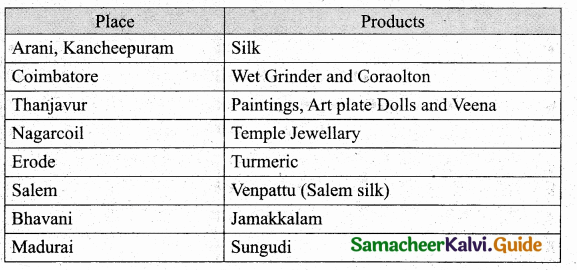
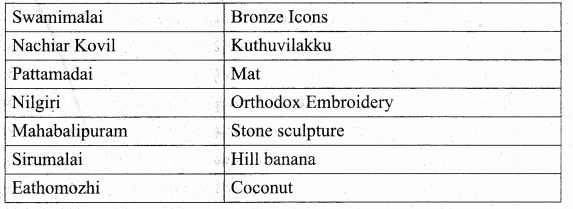
![]()
Question 7.
What is special about SEZs and write about the SEZs zones in Tamil Nadu.
Answer:
- Special Economic Zones (SEZs) provide an internationally competetive hassle free environment for exports.
- Units in SEZs manufacture goods and provide range of services.
- SEZs are located in Nanguneri, Ennore, Hosur and Perambalur.
- IT and ITES, SEZ named TIDEL – IT and TIDEL IIT and Bio – Pharmaceuticals SEZ are located in Chennai and Coimbatore SEZ called the TIDEL park IV is located in the city.
- Special Economic Zone means the specified area within the territory of the state.
- There are 36 special economics zone are operational in Tamil Nadu which tops in highest number of SEZ.
- It helps in the economic and Industrial development of the state.
- Helps to create employment opportunity and to earn foreign exchange.
IX. Map study
Question 1.
Industrial area
Answer:
(i) Textile Industry:
Cotton – Coimbatore, Tirupur, Erode.
Silk – Arani, Salem, Kancheepuram.
(ii) Leather Industry – Vellore.
Paper industry – Coimbatore, Karur, Erode.
Cement industry – Ariyalur, Virudhachalam.
(iii) Cities having Special Economic Zones (SEZ)
SEZ Zones: Chennai, Coimbatore.
![]()
